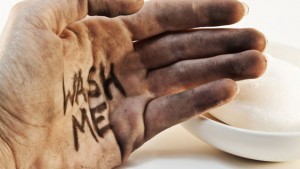Allergy is killing me and it’s time to pick up the subject again. The solution? A 12 year old school girl has the answer.
Potable water is one of the planet’s most precious resources, yet every day, millions of gallons are literally going down the drain. To challenge the normalcy of water waste, inventor David Vitez is proposing a new system, Robo-Washer™, that hopes to revolutionize our basic approach to washing our hands.
Consider that 17 gallons of water per person goes down American drains every day. Vitez’s prototype loses a mere cup of water per week. According to the company website, this “water recycling hand washer-sanitizer-dryer” is not only completely portable and self-contained, but the current working model, named “Revolution,” can wash and disinfect your hands by producing an anti-bacterial water without the use of soap. The unit then recycles this water after each use. All water loss is due to evaporation.
How does the Revolution hand washer/sanitizer/dryer work? Understandably, the website does not offer any technical details as there is no product yet on the market. But the company has presented at several expos meant to introduce new inventions in hopes of gaining investors. As Gizmag explains:
“It is like an automatic carwash for your hands. Plonk your hands in the hole, and rub them together as they’re sprayed with 360-degree soapy water at high pressure. Keep rubbing them together as it goes into a dry cycle, and Bob’s your uncle – end-to-end hand washing completed in a single device, totally touch-free and contained in a kind of bucket drain so there’s no mess or water spillage possible.”
The downside, Gizmag notes, is that it takes 90 seconds to run through the entire cycle from spraying to drying, and that minute -and-a-half feels like an “eternity.” Are Americans too impatient to embrace this new system? Maybe. But the necessary revolution must change how we think about water. In this regard, the Robo-Washer™ company is already doing good things.
A twelve-year-old girl named Iris Gupta hopes to stop allergic reactions before they start. Recently, the 6th grader made national headlines as one of the ten finalists for the “Discovery Education 3M Young Scientist Challenge.” The Challenge is open to students in grades 5 to 8, who submit projects of their own devising into this national competition.
What’s Gupta’s invention? She is hoping that inexpensive gold nanoparticles will replace antihistamines to suppress the symptoms of allergies. Nobody knows why symptoms are appearing in higher numbers of people who have never had allergies before, but according to the Centers for Disease Control, more than 50 million Americans now endure the aggravation of constant sneezing, runny nose, itchy eyes, and hives—the classic symptoms of a low-level allergic response to ordinary substances such as pollen, grass, trees, and pet dander. In some individuals, the reactions can be so severe that they are life threatening: the symptoms of anaphylaxis include the inability to breathe. Allergies are the 6th leading cause of chronic illness in the U.S. with an annual productivity cost in excess of $18 billion.
Currently, most seasonal sufferers take some form of antihistamine to stop their noses from dripping. As their name implies, antihistamines counter histamines released by the body in response to a perceived attack by allergens—say, pollen from flowering trees. It’s histamines that produce all those annoying symptoms. By the same token, antihistamines are not a cure but a pharmacological Band aid.
Instead of medicating after the fact, it is easier and more effective to stop an allergic reaction from starting in the first place. Based on prior medical research, Gupta hypothesized that gold nanoparticles might work better than antihistamines, for they engage the histamine response before it starts and prevent it from cascading. Because they block allergens from binding with Immunoglobulin E antibodies (IgE) in the bloodstream, gold nanoparticles have the potential ability to head off the reaction before it starts.
It may work. It may not. She is only twelve years old. There is plenty of time for more experiments. Who knows? By thinking outside the box, maybe she will someday figure out a way to actually cure allergies altogether.





